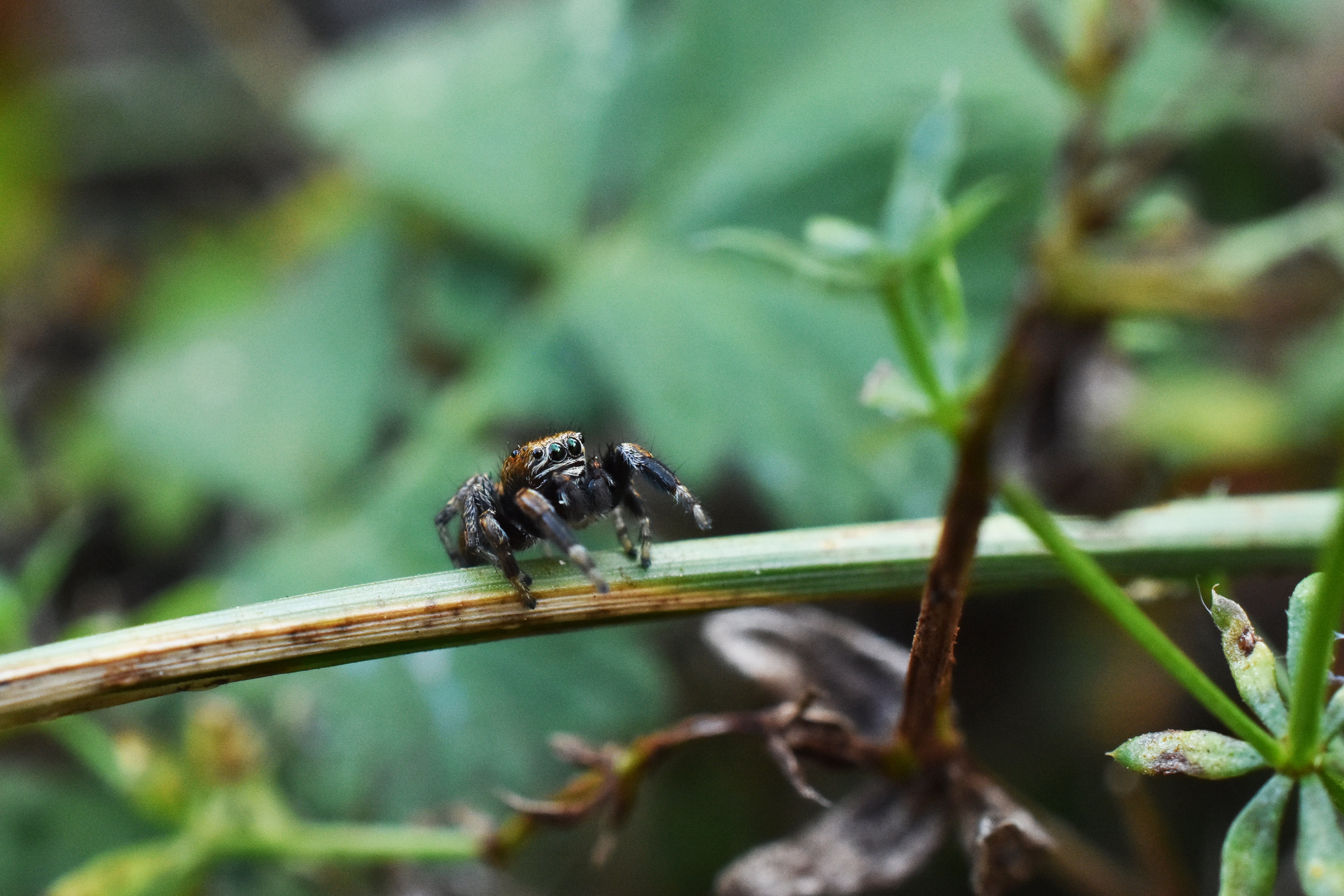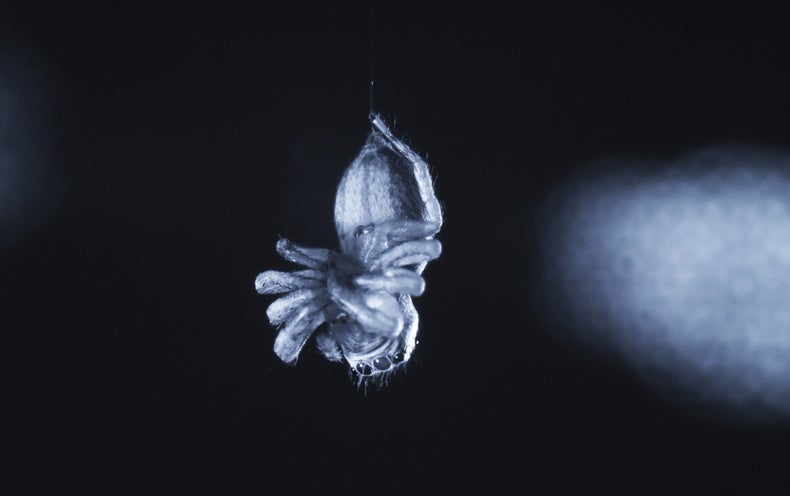Barred from her lab by pandemic restrictions, behavioral ecologist Daniela Rößler caught local jumping spiders and kept them in clear plastic boxes on her windowsill, planning to test their reactions to 3-D-printed models of predatory spiders. When she came home from dinner one night, though, she noticed something strange. “They were all hanging from the lids of their boxes,” says Rößler, a postdoctoral researcher at the University of Konstanz in Germany. She had never seen jumping spiders suspended motionless on silk lines like this before. “I had no idea what happened,” Rößler says. “I thought they were dead.”
It turns out the jumping spiders were simply asleep—and that Rößler had discovered an alternate sleeping habit of the species Evarcha arcuata, which had been known to build silk sleeping dens in curled-up dead leaves. But the real surprise came when she decided to spy on them all night. She bought a cheap night-vision camera, duct-taped some magnifying lenses to it (E. arcuata is typically around six millimeters long) and aimed it at a sleeping female spider. What Rößler saw on the recording astonished her.

Mostly the spider just hung there. But then her legs started to twitch, and her abdomen and even her silk-producing spinnerets did so as well. Sometimes her legs curled in toward her sternum. With every spider Rößler recorded, these odd movements only appeared during distinct bouts that lasted a little more than a minute and occurred periodically throughout the night. “They were just uncontrollably twitching in a way that really looked a lot like when dogs or cats dream and have their little REM phases,” she says.
Rapid eye movement (REM) sleep involves a state of partial or near-total muscle paralysis paired with an active, awakelike brain state, which is why it is sometimes called “paradoxical sleep.” In humans, this state has been strongly linked with dreaming. Rößler and her colleagues wondered if the twitching spiders could be experiencing something like an REM phase of sleep and possibly even having dreams. “We were like, ‘Okay, that would be insane,’” she says. Then she thought, “Let’s figure it out,” and immediately changed her research plans for the spiders.
There is abundant evidence for REM sleep or an analogous state in many mammals and birds. Scientists have also found something similar in two reptile species and hints of a state like it in zebra fish. Both octopuses and cuttlefish appear to have an REM phase, complete with eye movements, arm twitches, and rapid skin color and texture changes that resemble displays they perform when awake. Beyond those animals, there are glimmers but not much evidence of REM sleep in invertebrates, including insects and arachnids.
“It wouldn’t surprise me at all if [jumping spiders] have dreams,” says behavioral ecologist Lisa Taylor, who studies the spiders at the University of Florida and was not involved in the new research. “They live in such a rich sensory world, and we know they have amazing cognitive capabilities and memory.”
The jumping spiders offered a unique opportunity to expand the realm of dreaming animals, in part because of particular aspects of their ocular anatomy. Though most spiders cannot move their eyes even while awake, jumping spiders have long tubes that shift their retinas around behind their large principal eyes. What’s more, for the first several days of life, the spiders’ exoskeleton is translucent, so those eye tubes are visible inside their head.
Jumping spiders discovered sleeping suspended on a silk line experience muscle twitches and eye movements similar to the REM sleep phase associated with dreaming in humans. Scientists revealed the eye movements by recording the sleep of baby spiders with translucent exoskeletons, revealing movement of the tubes that control the position of their retinas inside their heads. Credit: Daniela C. Rößler
When Rößler recorded 34 sleeping spiderlings, she found that their twitches were accompanied by unmistakable eye-tube movements that did not happen during other phases of sleep. “It’s beautiful. I mean, it’s crazy. It immediately makes a sleep researcher think about rapid eye movement sleep,” says entomologist Barrett Klein, who researches bee sleep at the University of Wisconsin–La Crosse and was not directly involved in Rößler’s work. “And to have the first indication that you could study such a thing or that it’s even relevant in arthropods is thrilling to me.”
But it is too soon to say for sure that the spiders are experiencing something akin to REM sleep in humans, Klein cautions. The researchers first need to confirm the spiders are actually asleep during this phase by showing that they are less responsive to their environment, he says.
Rößler and her “dream team” of co-authors have already started those tests. And she points out that the leg curling is a particularly striking aspect of the spiders’ REM-like phase because that pose is typically only seen in dead spiders. Spiders use hydraulic pressure maintained by muscles to keep their legs extended, and the curling could result from the muscle paralysis that typifies REM sleep. The team’s initial findings were published on Monday in Proceedings of the National Academy of Sciences USA.
The videos alone are fairly convincing, says Niels Rattenborg, who studies bird sleep at the Max Planck Institute for Biological Intelligence in Seewiesen, Germany, and was not involved in the new study. “If I had to bet money, and this is not very scientific, but I will predict that they are asleep,” in part because the movements do not look purposeful like the ones the spiders make when awake, he says.
To show the arachnids’ sleep is REM-like, the scientists will also need evidence that the spiders’ brains are active as they twitch and move their eyes, Rattenborg says. Measuring activity in a poppy-seed-sized brain will be challenging, but Rößler says there are potential ways to do it. For example, other scientists recently figured out how to insert an electrode into the brain of a different jumping spider species without deflating its pressurized body and killing it.
Studying REM sleep in a wide range of species, including these spiders, could help us better understand how it works and why it exists, Rattenborg says. Some have theorized that REM sleep’s characteristic eye movements in humans reflect visual scenes playing out while dreaming. This raises the exciting possibility that other animals that have an REM-like state also experience dreams. Scientists of course cannot ask animals about their dreams, but measuring brain activity might someday be another way to get at the question. We are still learning which patterns of brain activity are correlated with dreaming in humans, says neuroethologist Teresa Iglesias, who studies cephalopod sleep at the Okinawa Institute of Science and Technology in Japan and was not involved in the jumping spider research. “So it is very early to expect we’ll be able to identify dreaming in a physiological way in other animals,” she says.
Yet as clues that nonhuman animals dream continue to accumulate, the philosophical implications are potentially huge, says David Peña-Guzmán, a philosopher at San Francisco State University and author of the new book When Animals Dream: The Hidden World of Animal Consciousness. Dreaming offers an entry point into questions of awareness in other animals: it is difficult to imagine that even a simple dream is possible without something like an ego or an “I” experiencing it, he adds. So if spiders dream, “it might mean that we start talking about spiders having something like a minimal self,” says Peña-Guzmán, who was not involved with the spider research.
The jumping spiders’ visible eye tubes might offer a way to test the theory that rapid eye movements are related to visual dream sequences and if those scenes are replays of things the arachnids witnessed while awake, Rößler says. It may be possible to play spiderlings a video of a simple scene of, say, a cricket hopping while tracking and measuring their eye movements and then see if those movements are re-created during sleep.
Rößler also wants to look for REM sleep in other spider species and points out that it might look very different in animals that rely more on senses other than vision, such as spiders that use vibrations in their webs to detect when prey is caught. “Maybe orb weavers dream in vibrations,” she says. “I think the story is probably that REM is just as universal across the animal kingdom as sleep is, but we just haven’t looked.”
























































